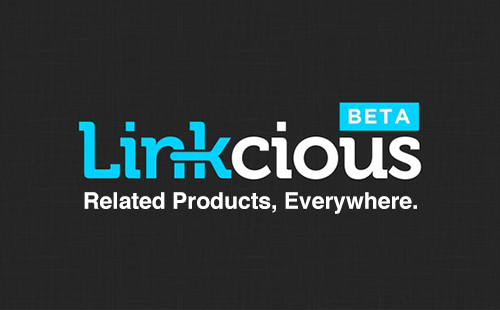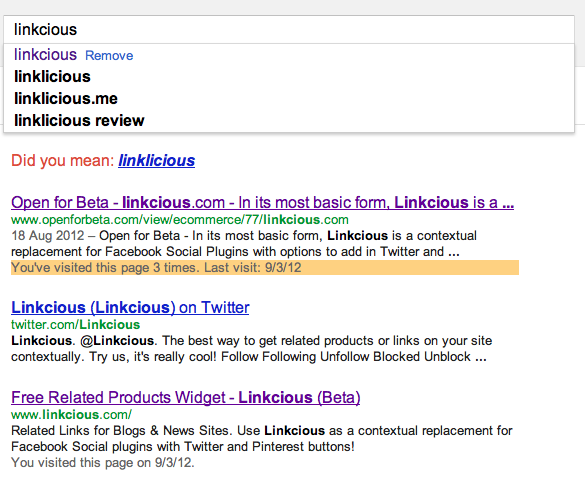
Starting today, we have roll out our new logo. Check it out above.

Starting today, we have roll out our new logo. Check it out above.

I think Linkcious is really easy to install. I mean, how difficult can it be? The steps: 1) Customise the layout, 2) Click on “Get Code”, 3) Stick the code onto pages where the you want your related products to show.
I don’t remember our first user or the second or the 105th but I know only 10% successfully install our widget. Encouragingly, users who have successfully installed Linkcious do not uninstall; they keep on using in almost perpetuity. However, not many users are able to successfully install.
Our successful install rate is much higher recently but still nothing near what we except. Hopefully Zopim chat will help us understand the problems users are facing during installation.
For the uninitiated, Zopim is a a live chat web widget. It claims that web owners can chat with visitors in real-time.
We are happy to announce that we have received funding from the Media Development Authority of Singapore under the i.JAM scheme today.
Linkcious.com is an intuitive product recommendation widget. It is currently the easiest solution available in the market for an Ecommerce merchant to get the highly coveted Amazon-like product recommendation widget without spending a bomb on programming fees. Linkcious is customizable and integrates seamlessly onto Ecommerce stores and blogs.
This investment will primarily help fuel the Company’s product development.
Using Linkcious product recommendations results in a dramatic increase in visitor engagement, content relevancy and revenue, whilst adding a cost saving opportunity at the same time.
To signup at Linkcious as a beta user, visit: http://linkcious.com.
Tip of the day: If you are using Google DFP to serve your product ads on another website, you can place the Linkcious Javascript codes into the Third party section in the Google DFP dashboard. This is really cool!
You can see an example below.
We built Linkcious because we cannot find a good related products widget that automatically selects products from a specified domain and places them contextually on any web page. Lets highlight one specific group of users who might be interested in this post:
E-Commerce merchants who want to show their products on their friend’s blog or on Google DFP.
In this post, we will show you how to use Linkcious to contextually show products from the Ikea store on our blog posts.


We all know that Google personalizes your search results by keeping logs of your web history but it is still scary to see what they can do with it. See the screenshot below to witness what I saw this morning and I don’t know about you but I was pretty pissed when I saw that (the highlighted portion). It may be a useful feature, but it felt like a violation of my privacy all the same.

It’s like they are a voyuer and they are scrawling details about me all over my screens.
I may have given Google the permission to track my web history but I don’t remember permitting Google to show this information on their SERPs. What if my boss sees me logging into a jobs site or my wife sees me checking out dogs after I told her I like cats? Let me know your thoughts below.
Even though this post is more about how Google uses the information they collect rather than another debate on why they shouldn’t collect browsing history, I have included instructions on disabling your web history below.
Read more
I started using CMS with PHPnuke (before I learnt php), then B2evolution, then Movable Type and I assure you nothing beats the ease of Wordpress. However, the ease ends with the installation process and sooner or later any user will whine about the frequent software updates. If you do choose to use WordPress, you will be stuck in an endless loop of updates and the problem escalates with every installed plugin.

For this spanking new Linkcious Blog, we have decided to go with WordPress as we totally understand what we are getting ourselves into and Blogspot is out of the question for corporate purposes. So here are the customary 2 things that I usually do after a new installation because these are really important even if nobody reads my posts.
A little update on Linkcious since I have not blogged for a while as the November, December months were very busy for us (we needed to fulfill large orders during Christmas for our E-commerce channels) and we were collecting click data from the alpha users of Linkcious.
Things are proceeding well and we will be doing A/B testing on different probability distributions to select relevant products to show up as Linkcious links next week. I will elaborate on that on a separate post.
One final note: We have only accepted just 200 users and have not sent out any new invites since October 2012. So stay tune if you have not receive our invites!
The Facebook Recommendations Box is not good enough because of these 5 points:
… then it hit us. The technology used to pick out related products must be far more accurate than any algorithm to generate recommended news. This is because recommended news articles may not need to be related or semantical at all.
But for the heck of it, let’s try to use Linkcious to generate related news and see what happens.
It turns out that Linkcious works very well as a contextual replacement for Facebook Recommendations Box. Early indication from A/B testing shows that the average click though rates from Linkcious is a whopping 8 times higher.